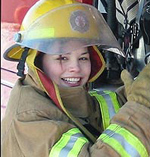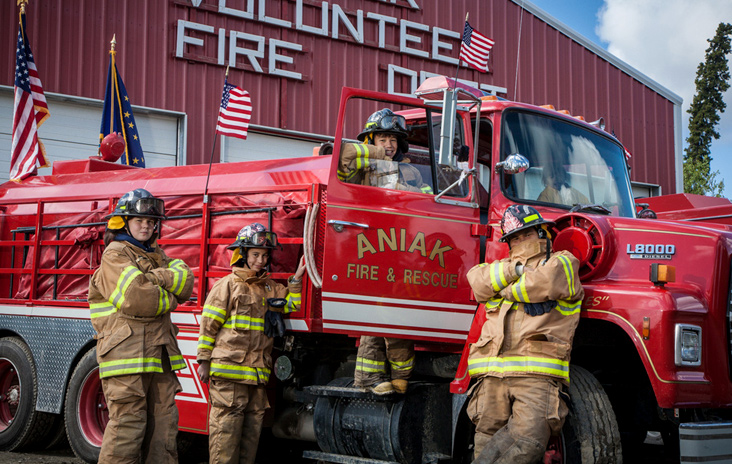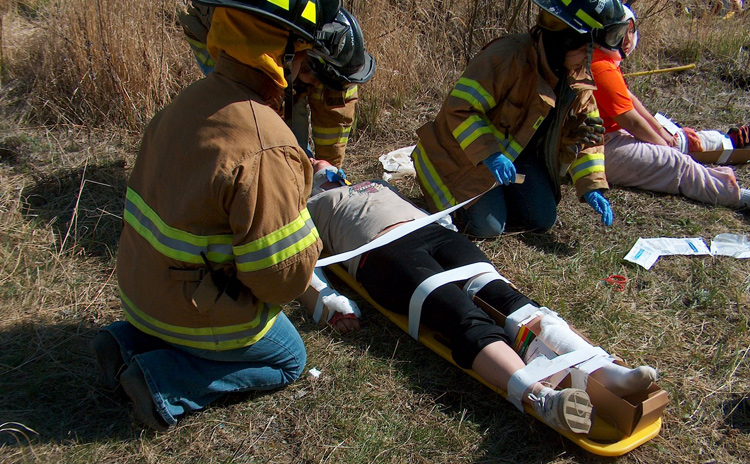
|
OTHER WKCD WEBSITES SPECIAL COLLECTIONS Students as Allies in School POPULAR WKCD PUBLICATIONS (PDFS] A Guide to Creating Teen- Cultural Conversations through Creative Writing Documenting Immigration Stories First Ask, Then Listen: How Your Students Can Help You Teach Them Better Making Writing Essential to Profiles of Politically Active Youth Queer Youth Advice for Educators The Schools We Need: Creating Small High Schools That Work for Us
|
Dragon Slayers: Young Alaskan Olympians WKCD| FEB. 10, 2014
In 2003, WKCD shared a story about an amazing group of mostly teenage girls who had become volunteer firefighters and EMTs in their remote Alaskan village, Aniak. They called themselves the "Dragon Slayers." The team became instant heroes when In 2001, April and Patricia—19 and 15 at the time—helped with the marathon rescue of two boys who had collided on snowmachines. The call took 34 hours. In the decade since, the team has continued to make emergency medical and rescue calls, 24/7, up and down the Kuskokwim River Valley. Growing up in one of the poorest regions of the state, former Dragon Slayers have become health aides, nurses, paramedics. April Kameroff is now the villager's new EMS chief. Another became an ambulance driver and medic in Afghanista. Several graduates went on to nursing school. A couple work in hospices. Both children of the fire chief, Pete Smith, who got it all started, have served as a rescue swimmer (Jeremiah) and corpsman (Mariah) for the Navy. Here we reprint the original story about these "angels in the snow"—a.k.a Alaskan Olympians—written in 2003 by Connect for Kids' reporter, Holly St. Lifer.
ANIAK, Alaska—On Christmas Day 2002, 14-year-old Erinn Marteney was at her best friend’s house when she smelled smoke. Marteney and the friend gathered up the friend’s four younger siblings and ran out. While standing barefoot in the snow, watching smoke pour out of the windows, Marteney noticed a 2-year-old child missing and ran back into the house. By that time the walls, ceilings and carpets were in flames. “I knew to drop to my knees and follow the wall,” Marteney says. “I couldn’t see a foot in front of my face and it hurt to breathe.” Undaunted, Marteney found the boy huddled behind the bathroom door and rushed him out to safety. For most teens, the decision to run into a burning building could be a costly one. But Marteney is trained to save lives. She’s a member of the Dragon Slayers, an all-girl firefighting and emergency medical team in Aniak, Alaska. A landlocked village of 750 people, Aniak is surrounded by rivers; the nearest major city is Anchorage, 350 miles west. With 160 hours of combined emergency trauma and firefighting training, the Dragon Slayers respond to about 300 calls a year, servicing an area of 14 villages with 3,000 residents. Team members have rescued survivors of plane crashes and snowmobile accidents. They have revived loved ones who have overdosed and grandmothers in cardiac arrest. Just this past December, they began a search that is still underway to find the body of a 15-year-old boy who fell through the ice and drowned. Anything boys can do The idea of recruiting teenagers was the brainchild of Aniak firechief Pete Brown, a retired Vietnam medic. In 1993, his 14-year-old son Jeremiah was hit by a four-wheeler, a popular recreational vehicle. At that time, the village lacked an experienced EMS crew. “All we had were a few health aides who were neither trained or equipped to handle this kind of emergency,” Brown says. “Only one volunteer showed up and then it took 45 minutes just to get Jeremiah off the snow, let alone treated,” says Brown. The next day, Brown began raising money to buy the equipment and pay for emergency medical training. According to Brown, everyone knew there was a tremendous need for an expanded EMS team. “In one month, we were able to raise $3,000 through community dances, raffles and local business donations—enough to train 12 people and buy basic emergency medical equipment,” Brown says. As soon as they were up and running, the response was overwhelming. “To give you an idea of the enormous demand,” Brown says, “In the first year, we jumped from 25 calls to 250.” The eight adults in the department couldn’t handle it all so Brown started recruiting high school kids, mostly girls. Why weren’t boys interested? “Male supremacy is still big out here in Eskimo culture,” Brown says. “The boys also resist the military-like aspect of the department.” There’s strict criteria for staying on board: Members have to make 90 percent of the meetings—ongoing training that takes place twice a week for two hours. Tobacco, alcohol and drugs are prohibited. And although these high school heroines are on call 24/7, they have to maintain passing grades. Brown makes it clear that the girls’ level of training and competency is on par with adults. He goes out on every call with the Dragon Slayers, and he is selective about what each girl actually does on each call based on experience and age. Still, it’s obviously a job with risks. Are the girls ever scared? “The only thing that scares you is the sound of the pager startling you at three in the morning,” says 17-year-old Erica Kameroff, who joined the crew as a sophomore. “But the adrenalin takes over. You don’t think about anything but doing whatever has to be done, whether it’s medical or fire.”
Mass casualty drill. Photo credit: Ed Morgan Putting emotion aside Lydia Hess, a 17-year-old firefighter from Boulder, Colorado, came to Aniak last year to become a Dragon Slayer. “I read about them and I wanted to work alongside kids my own age,” Hess says. She finds the quality of care and the level of professionalism equal to that of a big city department, but there are two significant differences. Getting to the victims in arctic Aniak—most of whom, like the Dragon Slayers, are Yupik Eskimos and Athabascan Indians—is far more challenging than hopping into an ambulance and driving to the scene. Through early May, the team uses frozen waterways as roads, traveling in snowmobiles and four-wheelers. When the ice melts, they often rely on boats. “And here, members of the team almost always know the person who’s injured or sick. So it’s very personal. There’s an emotional aspect to knowing the victim your whole life that you don’t have in a larger city,” Hess says. A particularly difficult call for Marteney was treating a good friend who overdosed on ibuprofen. “It was pretty hard to see him like that, but you learn to put your emotions aside and use your training to help the person,” Marteney says. “It’s not until afterward that your emotions kick in.” Another overdose victim was the mother of one of the Dragon Slayers. “As hard as that was, we needed everyone on the call,” says Brown, who incorporates grief management into the training. “After we have a really hard call we all meet at the fire station. We talk about the person we may have lost, what happened on the call, what we did right,” says Marteney. “Then we do a group hug and go for a walk. It really helps.” A world of opportunities Brown’s brigade of young adults not only provides vital services to an indigent, isolated region, it opens up a world of opportunities for its members that would never be available to them otherwise. “Unless you want a job unloading and loading planes, there’s not much to strive for here,” says Brown. All of the Dragon Slayers who have left Aniak have gone on to related careers. Three alumni, one of them Brown’s daughter Mariah, are now medic rescue swimmers for the Navy; four others attend universities around the country studying medicine. “This experience gave me the confidence to go all the way,” says Kameroff, who was granted a full four-year academic scholarship to the University of Alaska Fairbanks. Marteney plans to stay in emergency medicine. Hess is applying to the Coast Guard Academy. The four other Dragon Slayers all plan to pursue careers in medicine. When they do move on they will be replaced by a younger group—four girls and one boy—known as the Lizard Killers, now in training. “Girls graduate from this program and feel like they’re ready to take on the world,” says Brown. “And they do.”
What Kids Can Do, Inc. | info@whatkidscando.org | www.whatkidscando.org P.O. Box 603252 | Providence, RI 02906 | (401) 247-7665 phone | (401) 245-6428 fax
|



